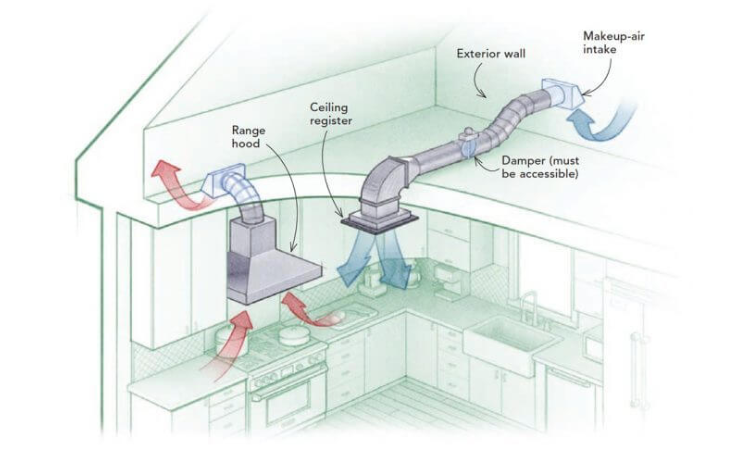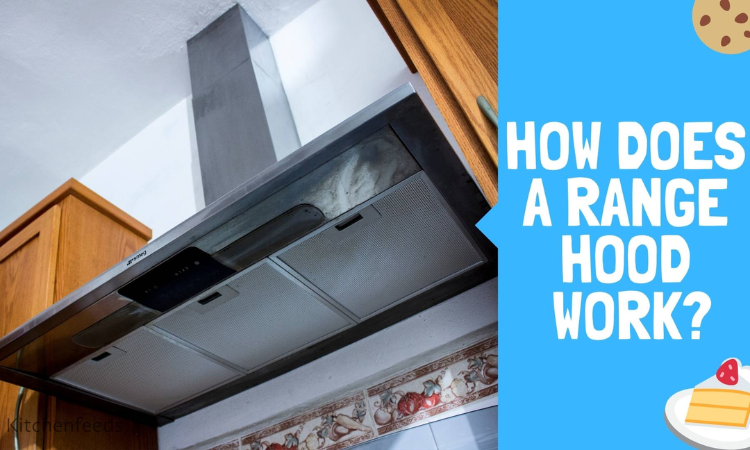How Does A Range Hood Work?: Let your mind wander to a time when the aroma of a mouth-watering stir-fry or feast wafts through your home. While the tantalizing scents are sure to excite, they have the potential to leave behind oily particles and an unpleasant aftertaste. Introducing the range hood: the unsung hero of your kitchen. Having said that, have you ever wondered, “How does a range hood work?” Let’s delve into the inner workings of this culinary buddy and uncover its secrets.
How to Use a Range Hood Basics?
Let me present to you the Kitchen Guardian
You may improve air circulation over your stovetop by installing a range hood. Extractor hood, exhaust hood, and vent hood are some of its alternative names. The primary goal is to remove odors, steam, oil, and smoke from the air when cooking.
The Anatomy of the Range Hood
Ductwork, filters, a blower or fan, and a cover are the components that make up a range hood. The canopy traps the flying debris as the fan draws in air and expels it down the ducts.
The Magic of Deletion
The Role of Supporters
A range hood cannot function without its fan or blower. During cooking, the fan creates a suction effect, sucking in air that is tainted with food particles.
Removing the Undesired
To prevent grease particles from recirculating in the kitchen air, range hood filters collect them. There are two types of these filters, mesh, and baffle, and they both serve a unique purpose.
Ventilation Methods
Methods—Ducted vs. Ductless
Range hoods typically come with two different ventilation options: ductless and ducted. A ducted hood will employ a duct system to send the filtered air outside, whereas a ductless hood will simply recirculate the air within the kitchen.
Ducting: A Quiet Exhaust System
Ducted systems prevent the recirculation of air by directing it outside via a network of ducts. The configuration is designed to effectively eradicate odors while maintaining appropriate air quality.
Intelligent Components for Modern Living
Adaptable Velocity
Most newer range hoods have variable fan speeds. By changing the ventilation strength to your cooking needs, you can reduce noise while using less electricity.
LED Lights
Adding integrated LED lights to your range hood is a great way to light up your kitchen and make things easier to see. This multifunctional piece will add value to your kitchen.

Maintenance and Care Suggestions
Regular Cleaning Routines
Maintaining a clean range hood is key to keeping it in top working order. Preventing the accumulation of oil and dirt requires regular cleaning of the hood’s surfaces, grease traps, and filters. This not only makes your gadget more efficient, but it also increases its lifespan.
Replace the Filters
Think about replacing the filters in your range hood often if it has any. Filters can become less effective due to grease saturation as time goes on. The user manual that came with your appliance will provide the specifics on how and when to change the filters.
Reducing Energy Use in Real-Life
Models that Conserve Energy
As a part of their commitment to sustainability, manufacturers provide variants of range hoods that are energy efficient. These appliances are designed to meet the standards of green kitchens by using less electricity without compromising on functionality.
Circular Air Movements
Some newer range hoods have automatic ventilation timers. By setting the timer, you can make sure the hood runs for the specified amount of time after cooking, removing any lingering scents without wasting power.
Methods for Minimizing Background Noise
Subtle Operation
These days, it’s not uncommon for range hoods to employ noise reduction techniques, which allow them to run almost silently. For open-concept kitchens, where a low noise level is essential for a pleasant cooking environment, this function is a godsend.
Levels expressed in dB
Consider the range hood’s decibel rating, which indicates the noise level, before making a purchase. Reduced decibel levels indicate quieter operation, which is great for those times when you want to cook without disturbing others.
To wrap things up:
You can make an educated decision when choosing a range hood for your kitchen when you know how they work and what maintenance is required. Whatever your cooking needs may be—more energy efficiency, less noise, or smart features—there is a range hood out there to meet them.
Let the range hood do its chores in harmony with the rest of your kitchen, ensuring that the heart of your home remains clean, odor-free, and a source of creative inspiration for your cooking. Modern innovations in design and technology are taking the humble range hood to new heights, heralding a future where cutting-edge ventilation systems not only make cooking more enjoyable but also healthier.
I hope you like the part where we talked about How Does A Range Hood Work? For more content like this, visit our website Kitchenmatts.com.


You are a very intelligent person!